Soave
If you are looking for a destination for a tourist trip around Verona, Soave is definitely the destination for you. The village with the castle and the surrounding area offer many possibilities for guided tours on historical and artistic themes, food and wine experiences in the many wineries in the area, naturalistic excursions.
Contacts
For more information or to contact a
tourist guide of Soave:
Soave Guide
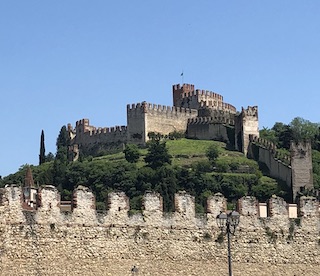 The
main attraction of this territory is certainly the castle of
Soave. From the top of Mount Tenda it dominates the village below
and the plain that surrounds it with its expanses of vineyards.
The castle is clearly visible in the distance already from the
highway when you approach the exit of Soave.
The
main attraction of this territory is certainly the castle of
Soave. From the top of Mount Tenda it dominates the village below
and the plain that surrounds it with its expanses of vineyards.
The castle is clearly visible in the distance already from the
highway when you approach the exit of Soave.
The castle, as we can see today, is the result of the enlargement
wanted by Cansignorio della Scala, lord of Verona, at the
end of the 14th century. The castle is as typical as
you can imagine when you think of a medieval manor, with
towers, high crenellated walls, patrol walkways, drawbridges and
shutters, dungeons and torture rooms, armors and echoes
of contrasting love stories between noble ladies and
knights.
A tour guide of the castle of Soave can accompany you on an
in-depth visit illustrating all aspects of the fortress and making
you relive the atmosphere of times gone by.
The Village
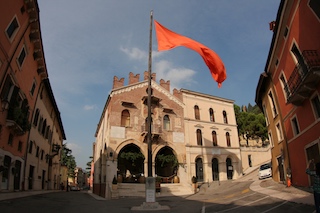 Strictly
linked to the presence of the castle of Soave is the village
below, protected by walls and towers that extend from the keep of
the manor.
Strictly
linked to the presence of the castle of Soave is the village
below, protected by walls and towers that extend from the keep of
the manor.
From the Scala family fortress it is possible to reach the center
of the village along an picturesque panoramic path.
In the heart of the town is Piazza Antenna, with the flagpole
donated by Venice in the center to thank the villagers
of Soave for their loyalty to the Republic of San Marco during the
war against the Cambrai League at the beginning of the 16th
century. From it waved the great flag of Venice, still hoisted
during holidays and historical re-enactments.
The square is completed by Palazzo Cavalli, an elegant
example of late-Gothic Venetian architecture, and the
old Palazzo della Ragione, the ancient
court of the Scala era.
The walkway along the ancient walls of the village with its towers
and ancient access doors is also very suggestive.
Roman Age
The history of Soave dates back to Roman times. Right where today the A4 Milan-Venice motorway runs, from the middle of the second century BC, ran the Via Postumia, one of the most important roads in northern Italy, which connected the two important ports of Genoa and Aquileia. The Via Postumia, like all the roads on which the Roman army moved, was first of all a military infrastructure, and as such guarded by watchtowers that interspersed along its route. On Mount Tenda, where today stands the castle of Soave almost certainly was built one of these watchtowers. Standing on the high fourteenth-century keep that dominates the plain and the traffic of the motorway, you can still understand its perfect strategic position.
Barbaric Invasions
Along the ancient Via Postumia also marched the barbarians who from across the Alps invaded the rich territories of the Roman Empire from the third to fourth century AD. Near the tower, where probably settlements had arisen, one of the many Germanic tribes that made up the varied barbarian world settled: the Swabians. From a progressive mutation of the pronunciation of the Latin word "Svevi" in "Suebi" or "Suevi", would derive the name of the village: Soave. The new occupants probably expanded and reinforced the outpost on the hill that began to take the appearance of a fortress.
Scala Family
The castle of Soave maintained, and indeed increased its
strategic role, with the rise to power in Verona of the
Scala family from the second half of 1200. The castle
became an important outpost for the skirmishes against the Count
of San Bonifacio of whom they were adversaries, and for the
subsequent expansion of their possessions to the east.
It was Cansignorio della Scala, the last of the
great Scala lords, who enlarged the castle and extended the walls
to defend the entire village. Previously, in fact, the population
of the defenseless village, in case of danger, found shelter
inside the first two large empty courtyards of the castle.
Venice
Like all Scala family possessions, Soave also became part of the
state of the Republic of Venice in 1405. A
garrison and a captain appointed by the Serenissima Republic took
the place of the Scala feudal lord and his soldiers.
At the beginning of 1500 Venice was faced with the threat of the
League of Cambrai, an alliance between the Holy Roman
Empire, France and Spain, promoted by the Pope against an
increasingly powerful lagoon republic. Soave was easily occupied
by the imperial troops, and many villagers were slaughtered for
refusing to surrender to the new occupiers.
Decadence and Rebirth
In the end the League broke up and Soave returned to Venice, but
the new technologies of war, with the introduction of
gunpowder, soon made the castles, once impregnable if not with
long sieges, useless and fragile residues of an era now
past.
The castle of Soave was then abandoned, slowly
going into ruin until it was transformed into a farm.
After the annexation of Verona to the Kingdom of Italy in 1866,
the castle of Soave was purchased by Giulio Camuzzoni, the first
mayor of Verona and senator of the Kingdom with a passion for
history. He put resources and energy into the restoration of the
ancient fortress, restoring its dignity and recreating a part of
the interior. The castle is still private property and is open to
the public with regular visiting hours.
The Wine
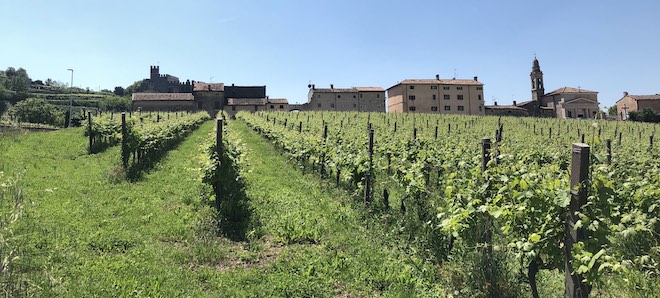
No less famous than the Castle is certainly the Soave wine, still one of the most exported white wines in Italy. Soave DOC is produced mainly from Garganega grapes, a native vine that grows exclusively in this area, to which can be added small percentages of Chardonnay and Trebbiano di Soave.
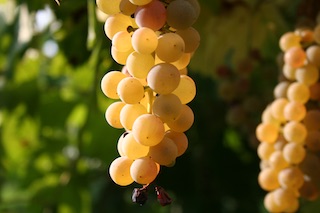 One
of the things that most impresses visitors who climb to the top of
the keep of the castle of Soave and admire the extraordinary
panorama of the valley and the surrounding hills, is the endless
expanse of vineyards. A real "sea of grapes"
that is harvested in Autumn, pressed and transformed into tasty
wine in the many wineries in the area. The best part of this grape
is selected and left to dry on racks and in wooden crates in
special floors above the wineries. The liquid content is reduced
and the sugar content is increased, while at the same time
developing very special aromas. The grapes will then be pressed in
winter and will become the precious Recioto di Soave,
a refined sweet wine for meditation or for pairing with desserts
and cheeses.
One
of the things that most impresses visitors who climb to the top of
the keep of the castle of Soave and admire the extraordinary
panorama of the valley and the surrounding hills, is the endless
expanse of vineyards. A real "sea of grapes"
that is harvested in Autumn, pressed and transformed into tasty
wine in the many wineries in the area. The best part of this grape
is selected and left to dry on racks and in wooden crates in
special floors above the wineries. The liquid content is reduced
and the sugar content is increased, while at the same time
developing very special aromas. The grapes will then be pressed in
winter and will become the precious Recioto di Soave,
a refined sweet wine for meditation or for pairing with desserts
and cheeses.
Cellar Tours
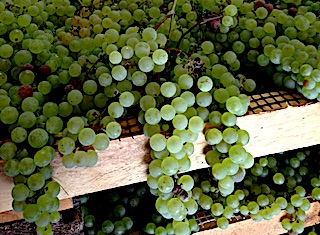 The
natural completion of a guided tour of the Castle of Soave and the
village, is a visit to the winery with tasting of wines
and local products. In Soave and the surrounding
cellars up to Monteforte d'Alpone, there are many wineries that
you can visit. Some of them are right inside the village or very
close to it, such as Corte Mainente, Coffele, Pieropan, Cantina
del Castello or Borgo Rocca Sveva, or in a panoramic position. The
visit includes a walk in the vineyards, a stop in the barrel room
and a tasting of a selection of wines that you can accompany some
local products such as Soppressa Veneta, Monte Veronese cheese,
Sbrisolona. From October to January it is also possible to see the
grapes for the production of Recioto di Soave in the drying of the
fruit.
The
natural completion of a guided tour of the Castle of Soave and the
village, is a visit to the winery with tasting of wines
and local products. In Soave and the surrounding
cellars up to Monteforte d'Alpone, there are many wineries that
you can visit. Some of them are right inside the village or very
close to it, such as Corte Mainente, Coffele, Pieropan, Cantina
del Castello or Borgo Rocca Sveva, or in a panoramic position. The
visit includes a walk in the vineyards, a stop in the barrel room
and a tasting of a selection of wines that you can accompany some
local products such as Soppressa Veneta, Monte Veronese cheese,
Sbrisolona. From October to January it is also possible to see the
grapes for the production of Recioto di Soave in the drying of the
fruit.
For more information and details on guided tours in the province
of Verona:
